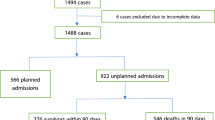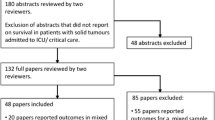Abstract
Objective
To evaluate the impact of two different comorbidity measures on the 6-month mortality of severely ill cancer patients.
Design and setting
Prospective cohort study in a ten-bed oncological medical-surgical intensive care unit (ICU).
Patients
A total of 772 consecutive patients were included over a 45-month period. The mean age was 57.6±16.4 years, and 642 (83%) patients had solid tumors.
Measurements and results
Data were collected on admission and during ICU stay. Comorbidities were evaluated using the Charlson Comorbidity Index (CCI) and the Adult Comorbidity Evaluation (ACE-27). The ICU, hospital, and 6-month mortality rates were 34%, 47%, and 58%, respectively. The most frequent comorbidities were hypertension (33%), diabetes mellitus (8%), and chronic pulmonary disease (7%). There were important differences between the two indices regarding the comorbidity evaluation. Using the ACE-27, 389 patients (50%) had comorbid ailments that were classified as mild (31%), moderate (14%), and severe (5%) according to the comorbidity severity. According to the CCI, 212 patients (27%) had a comorbidity, and their median score was 1 (1–2). In the multivariable Cox proportional hazard models only the presence of a severe comorbidity by the ACE-27 was associated with increased mortality. The CCI was not independently associated with the outcome. Other outcome predictors were older age, poor performance status, active cancer, need of mechanical ventilation, and severity of acute organ failures.
Conclusions
Severe comorbidities must be considered in the outcome evaluation of ICU cancer patients. The ACE-27 seems to be a useful instrument for prognostic assessment in this population.

Similar content being viewed by others
References
Azoulay E, Alberti C, Bornstain C, Leleu G, Moreau D, Recher C, Chevret S, Le Gall JR, Brochard L, Schlemmer B (2001) Improved survival in cancer patients requiring mechanical ventilatory support: impact of noninvasive mechanical ventilatory support. Crit Care Med 29:519–525
Azoulay E, Moreau D, Alberti C, Leleu G, Adrie C, Barboteu M, Cottu P, Levy V, Le Gall JR, Schlemmer B (2000) Predictors of short-term mortality in critically ill patients with solid malignancies. Intensive Care Med 26:1817–1823
Benoit DD, Vandewoude KH, Decruyenaere JM, Hoste EA, Colardyn FA (2003) Outcome and early prognostic indicators in patients with a hematologic malignancy admitted to the intensive care unit for a life-threatening complication. Crit Care Med 31:104–112
Kress JP, Christenson J, Pohlman AS, Linkin DR, Hall JB (1999) Outcomes of critically ill cancer patients in a university hospital setting. Am J Respir Crit Care Med 160:1957–1961
Staudinger T, Stoiser B, Mullner M, Locker GJ, Laczika K, Knapp S, Burgmann H, Wilfing A, Kofler J, Thalhammer F, Frass M (2000) Outcome and prognostic factors in critically ill cancer patients admitted to the intensive care unit. Crit Care Med 28:1322–1328
Groeger JS, Lemeshow S, Price K, Nierman DM, White P Jr, Klar J, Granovsky S, Horak D, Kish SK (1998) Multicenter outcome study of cancer patients admitted to the intensive care unit: a probability of mortality model. J Clin Oncol 16:761–770
Massion PB, Dive AM, Doyen C, Bulpa P, Jamart J, Bosly A, Installe E (2002) Prognosis of hematologic malignancies does not predict intensive care unit mortality. Crit Care Med 30:2260–2270
Piccirillo JF, Tierney RM, Costas I, Grove L, Spitznagel EL Jr (2004) Prognostic importance of comorbidity in a hospital-based cancer registry. JAMA 291:2441–2447
Read WL, Tierney RM, Page NC, Costas I, Govindan R, Spitznagel EL, Piccirillo JF (2004) Differential prognostic impact of comorbidity. J Clin Oncol 22:3099–3103
Yancik R, Ganz PA, Varricchio CG, Conley B (2001) Perspectives on comorbidity and cancer in older patients: approaches to expand the knowledge base. J Clin Oncol 19:1147–1151
Groeger JS, White P Jr, Nierman DM, Glassman J, Shi W, Horak D, Price K (1999) Outcome for cancer patients requiring mechanical ventilation. J Clin Oncol 17:991–997
Soares M, Fontes F, Dantas J, Gadelha D, Cariello P, Nardes F, Amorim C, Toscano L, Rocco JR (2004) Performance of six severity-of-illness scores in cancer patients requiring admission to the intensive care unit: A prospective observational study. Crit Care 8:R194–R203
Le Gall J-R, Lemeshow S, Saulnier F (1993) A new simplified acute physiology score (SAPS II) based on a European/North American multicenter study. JAMA 270:2957–2963
Vincent JL, Moreno R, Takala J, Willatts S, De Mendonca A, Bruining H, Reinhart CK, Suter PM, Thijs LG (1996) The SOFA (Sepsis-related Organ Failure Assessment) score to describe organ dysfunction/failure. On behalf of the Working Group on Sepsis-Related Problems of the European Society of Intensive Care Medicine. Intensive Care Med 22:707–710
Zubrod CG, Schneiderman M, Frei III E, Brindley C, Gold GL, Shnider B, Oviedo R, Gorman J, Jones Jr R, Jonsson U, Colsky J, Chalmers T, Ferguson B, Dederick M, Holland J, Selawry O, Regelson W, Lasagna L, Owens Jr AH (1960) Appraisal of methods for the study of chemotherapy of cancer in man: comparative therapeutic trial of nitrogen mustard and triethylene thiophosphoramide. J Chronic Dis 11:7–33
Bone RC, Balk RA, Cerra FB, Dellinger RP, Fein AM, Knaus WA, Schein RM, Sibbald WJ (1992) Definitions for sepsis and organ failure and guidelines for the use of innovative therapies in sepsis. The ACCP/SCCM Consensus Conference Committee. American College of Chest Physicians/Society of Critical Care Medicine. Chest 101:1644–1655
Garner JS, Jarvis WR, Emori TG, Horan TC, Hughes JM (1988) CDC definitions for nosocomial infections, 1988. Am J Infect Control 16:128–140
Johnston AS, Piccirillo JF, Creech C, Littenberg B, Jeffe D, Spitznagel EL (2001) Validation of a comorbidity education program. J Registry Manage 28:125–131
Charlson ME, Pompei P, Ales KL, MacKenzie CR (1987) A new method of classifying prognostic comorbidity in longitudinal studies: development and validation. J Chronic Dis 40:373–383
Kleinbaum DG (1996) Survival analysis: a self-learning text. Springer, Berlin Heidelberg New York
Kaplan EL, Meier P (1958) Nonparametric estimation from incomplete observations. J Am Stat Assoc 53:457–481
Schellongowski P, Benesch M, Lang T, Traunmuller F, Zauner C, Laczika K, Locker GJ, Frass M, Staudinger T (2004) Comparison of three severity scores for critically ill cancer patients. Intensive Care Med 30:430–436
Schapira DV, Studnicki J, Bradham DD, Wolff P, Jarrett A (1993) Intensive care, survival, and expense of treating critically ill cancer patients. JAMA 269:783–786
Sculier JP, Paesmans M, Markiewicz E, Berghmans T (2000) Scoring systems in cancer patients admitted for an acute complication in a medical intensive care unit. Crit Care Med 28:2786–2792
Johnston JA, Wagner DP, Timmons S, Welsh D, Tsevat J, Render ML (2002) Impact of different measures of comorbid disease on predicted mortality of intensive care unit patients. Med Care 40:929–940
Durairaj L, Will JG, Torner JC, Doebbeling BN (2003) Prognostic factors for mortality following interhospital transfers to the medical intensive care unit of a tertiary referral center. Crit Care Med 31:1981–1986
Needham DM, Bronskill SE, Sibbald WJ, Pronovost PJ, Laupacis A (2004) Mechanical ventilation in Ontario, 1992–2000: incidence, survival, and hospital bed utilization of noncardiac surgery adult patients. Crit Care Med 32:1504–1509
Lee H, Doig CJ, Ghali WA, Donaldson C, Johnson D, Manns B (2004) Detailed cost analysis of care for survivors of severe sepsis. Crit Care Med 32:981–985
Knaus WA, Draper EA, Wagner DP, Zimmerman JE (1985) APACHE II: a severity of disease classification system. Crit Care Med 13:818–829
Lemeshow S, Teres D, Klar J, Avrunin JS, Gehlbach SH, Rapoport J (1993) Mortality probability models (MPM II) based on an international cohort of intensive care unit patients. JAMA 270:2478–2486
Poses RM, McClish DK, Smith WR, Bekes C, Scott WE (1996) Prediction of survival of critically ill patients by admission comorbidity. J Clin Epidemiol 49:743–747
Paleri V, Wight RG (2002) Applicability of the adult comorbidity evaluation-27 and the Charlson indexes to assess comorbidity by notes extraction in a cohort of United Kingdom patients with head and neck cancer: a retrospective study. J Laryngol Otol 116:200–205
Romano PS, Roos LL, Jollis JG (1993) Adapting a clinical comorbidity index for use with ICD-9-CM administrative data: differing perspectives. J Clin Epidemiol 46:1075–1079
Grossman E, Messerli FH, Boyko V, Goldbourt U (2002) Is there an association between hypertension and cancer mortality? Am J Med 112:479–486
Sorensen HT, Mellemkjaer L, Olsen JH, Baron JA (2000) Prognosis of cancers associated with venous thromboembolism. N Engl J Med 343:1846–1850
Wehler M, Martus P, Geise A, Bost A, Mueller A, Hahn EG, Strauss R (2001) Changes in quality of life after medical intensive care. Intensive Care Med 27:154–159
Author information
Authors and Affiliations
Corresponding author
Additional information
This work was performed at the Intensive Care Unit of the Instituto Nacional de Câncer, Rio de Janeiro, Brazil. Financial support was provided by institutional departmental funds
Rights and permissions
About this article
Cite this article
Soares, M., Salluh, J.I.F., Ferreira, C.G. et al. Impact of two different comorbidity measures on the 6-month mortality of critically ill cancer patients. Intensive Care Med 31, 408–415 (2005). https://doi.org/10.1007/s00134-005-2554-z
Received:
Accepted:
Published:
Issue Date:
DOI: https://doi.org/10.1007/s00134-005-2554-z




